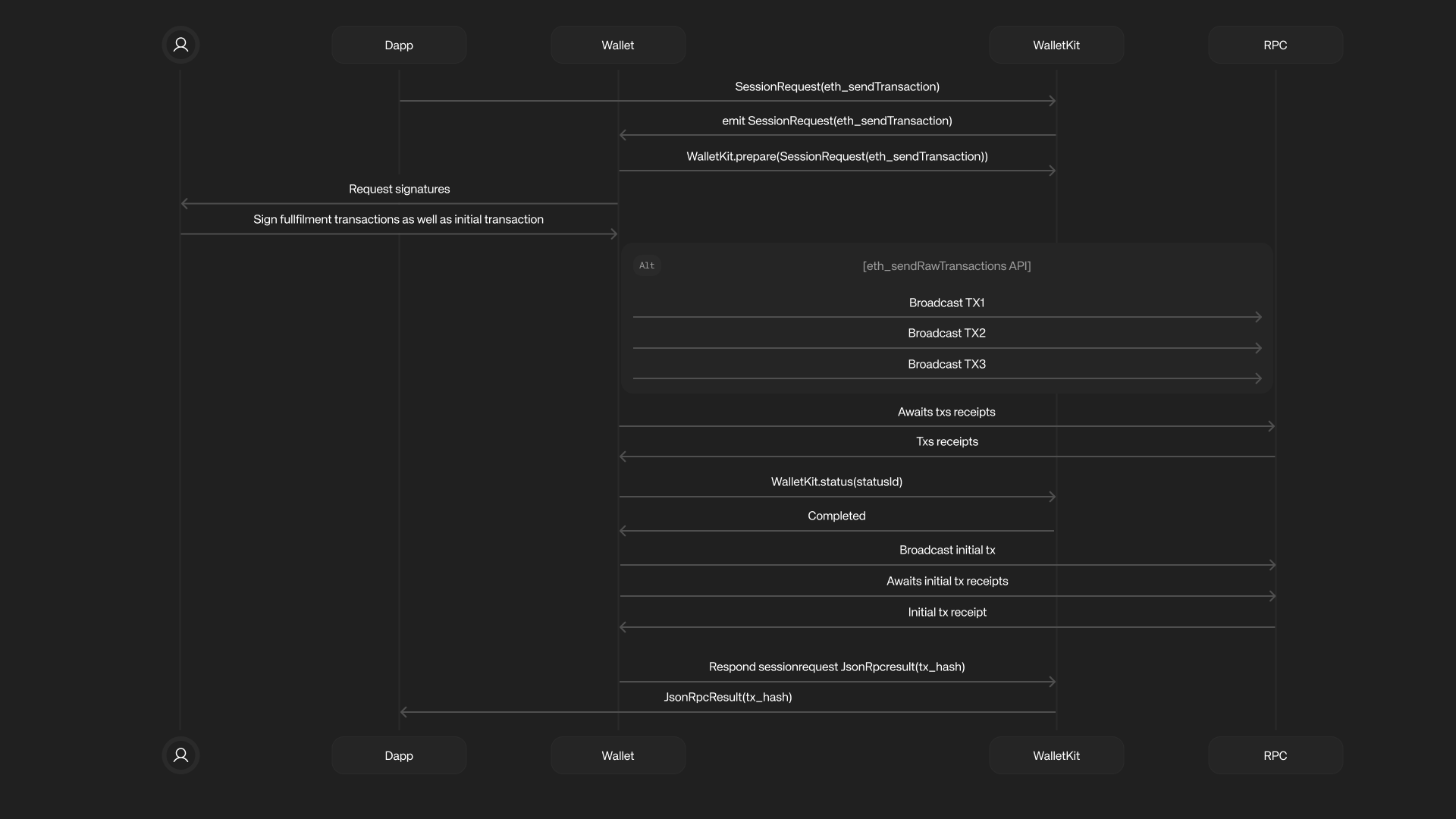Chain Abstraction
Chain Abstraction in WalletKit enables users with stablecoins on any network to spend them on-the-fly on a different network. Our Chain Abstraction solution provides a toolkit for wallet developers to integrate this complex functionality using WalletKit.
For example, when an app requests a 100 USDC payment on Base network but the user only has USDC on Arbitrum, WalletKit offers methods to detect this mismatch, generate necessary transactions, track the cross-chain transfer, and complete the original transaction after bridging finishes.
How It Works
Apps need to pass gas as null, while sending a transaction to allow proper gas estimation by the wallet. Refer to this guide for more details.
When an app sends a transaction request to your wallet, you need to:
- Check if the required chain has enough funds to complete the transaction or not
- If not, use the
preparemethod to generate necessary bridging transactions - Check the status of the bridging transactions and wait for them to be completed
- Once the bridging transactions are completed, execute the initial transaction
The following sequence diagram illustrates the complete flow of a chain abstraction operation, from the initial dapp request to the final transaction confirmation

Methods
Following are the methods from WalletKit that you will use in implementing chain abstraction.
💡 Chain abstraction is currently in experimental phase
Prepare
This method is used to check if chain abstraction is needed. If it is, it will return a response with the necessary transactions. If it is not, it will return a response with the original transaction.
@available(*, message: "This method is experimental. Use with caution.")
public func prepare(transaction: InitialTransaction) async throws -> PrepareResponse {
}
Wait For Success With Timeout
This method is used to wait for the all transactions to complete successfully. It will return a response with the transaction hash and receipt if the operation completed successfully. If the operation did not complete successfully, it will throw an error.
@available(*, message: "This method is experimental. Use with caution.")
public func waitForSuccessWithTimeout(orchestrationId: String, checkIn: UInt64, timeout: UInt64 = 180) async throws -> StatusResponseCompleted {
}
Estimate Fees
This method is used to estimate fees on a specific chain.
@available(*, message: "This method is experimental. Use with caution.")
public func estimateFees(chainId: String) async throws -> Eip1559Estimation {
}
Get UI Fields
Get UI fields that you can use to display like estimated fees in user's local currency for specific chain.
@available(*, message: "This method is experimental. Use with caution.")
public func getUIFields(chainId: String) async throws -> UIFields {
}
Usage
When your wallet receives an eth_sendTransaction request, first check if chain abstraction is needed using the prepare method, if it is, you need to sign all the fulfilment transactions and broadcast them in parallel.
After that, you need to call the waitForSuccessWithTimeout method to check the status of the fulfillment operation.
If the operation is successful, you need to broadcast the initial transaction and await for the transaction hash and receipt. If the operation is not successful, you need to send the JsonRpcError to the dapp and display the error to the user.
guard request.method == "eth_sendTransaction" else {
return
}
let tx = try request.params.get([Tx].self)[0]
let transaction = InitialTransaction(
chainId: request.chainId.absoluteString
from: tx.from,
to: tx.to,
value: "0",
input: tx.data,
)
let routeResponseSuccess = try await WalletKit.instance.prepare(transaction: transaction)
switch routeResponseSuccess {
case .success(let routeResponseSuccess):
switch routeResponseSuccess {
case .available(let routeResponseAvailable):
// sign and broadcast routing transactions and then the initial transaction
case .notRequired(let routeResponseNotRequired):
// user does not need to move funds from other chains, sign and broadcast original transaction
case .error(let routeResponseError):
// error has occured, respod with an error to a dapp
}
After broadcasting the transactions, use the waitForSuccessWithTimeout method to monitor their completion. Once all transactions are successful, you can proceed with broadcasting the initial transaction.
let orchestrationId = routeResponseAvailable.orchestrationId
print("📋 Orchestration ID: \(orchestrationId)")
print("🔄 Starting status checking...")
let completed = try await WalletKit.instance.waitForSuccessWithTimeout(orchestrationId: orchestrationId, checkIn: 5, timeout: 180)
print("✅ Routing Transactions completed successfully!")
print("📊 Completion details: \(completed)")
print("🚀 Initiating initial transaction...")
try await sendInitialTransaction(initialTransaction: routeResponseAvailable.initialTransaction)
For example, check out implementation of chain abstraction in sample wallet with Swift.
Testing
To test Chain Abstraction, you can use the AppKit laboratory and try sending USDC with any chain abstraction supported wallet. You can also use this sample wallet for testing.